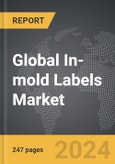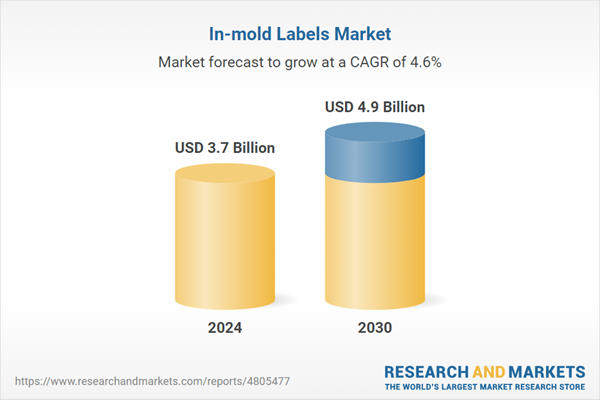The global market for In-mold Labels was valued at US$3.7 Billion in 2024 and is projected to reach US$4.9 Billion by 2030, growing at a CAGR of 4.6% from 2024 to 2030. This comprehensive report provides an in-depth analysis of market trends, drivers, and forecasts, helping you make informed business decisions. The report includes the most recent global tariff developments and how they impact the In-mold Labels market.
Segments: Technology (Injection Molding Process, Extrusion Blow-Molding Process, Thermoforming); Printing Technology (Flexographic Printing, Offset Printing, Gravure Printing, Digital Printing, Other Printing Technologies); End-Use (Food & Beverage, Personal Care, Consumer Durables, Automotive, Other End-Uses).
Geographic Regions/Countries: World; United States; Canada; Japan; China; Europe (France; Germany; Italy; United Kingdom; Spain; Russia; and Rest of Europe); Asia-Pacific (Australia; India; South Korea; and Rest of Asia-Pacific); Latin America (Argentina; Brazil; Mexico; and Rest of Latin America); Middle East (Iran; Israel; Saudi Arabia; United Arab Emirates; and Rest of Middle East); and Africa.
The analysts continuously track trade developments worldwide, drawing insights from leading global economists and over 200 industry and policy institutions, including think tanks, trade organizations, and national economic advisory bodies. This intelligence is integrated into forecasting models to provide timely, data-driven analysis of emerging risks and opportunities.
Global In-Mold Labels Market - Key Trends & Drivers Summarized
Why Are In-Mold Labels Becoming Increasingly Popular?
The global in-mold labels market is experiencing rapid growth, driven by the demand for high-quality, durable, and aesthetically pleasing labeling solutions across various industries. In-mold labels (IML) are integrated into the product during the molding process, creating a seamless, permanent bond between the label and the container. This technology is particularly popular in the packaging industry, where it offers advantages such as resistance to moisture, scratching, and peeling, as well as the ability to achieve complex designs and vibrant colors. The food and beverage industry is a major adopter of in-mold labels, as they provide an attractive, long-lasting labeling solution that enhances product shelf appeal and brand recognition. Additionally, the growing emphasis on sustainability is contributing to the market’s expansion, as in-mold labels are fully recyclable along with the product, reducing waste and supporting eco-friendly packaging initiatives.How Are Technological Innovations Shaping the In-Mold Labels Market?
Technological innovations are playing a key role in the evolution of the in-mold labels market, enabling more efficient production processes and expanding the range of applications for IML. Advances in printing technology, including digital printing, are allowing manufacturers to produce high-resolution, intricate designs directly on labels, enhancing the visual appeal of products. Furthermore, developments in molding equipment and robotics have streamlined the in-mold labeling process, making it more cost-effective and suitable for high-volume production. The introduction of smart labels, which incorporate RFID and NFC technologies, is also creating new opportunities for in-mold labels in areas such as inventory management, product authentication, and interactive packaging. These technological advancements are not only driving the adoption of in-mold labels but also enabling their use in new and emerging markets.What Role Does Industry Demand Play in Shaping the In-Mold Labels Market?
Industry demand is a significant driver of the in-mold labels market, with various sectors recognizing the benefits of this labeling technology in enhancing product quality and reducing production costs. The food and beverage industry remains a key market for in-mold labels, particularly for dairy products, beverages, and frozen foods, where durability and resistance to environmental factors are critical. The personal care and household products sectors are also increasingly adopting in-mold labels to achieve premium packaging designs that stand out on retail shelves. Additionally, the automotive and consumer electronics industries are exploring the use of in-mold labels for durable branding and product information directly on components. As industries continue to seek innovative, cost-effective labeling solutions that enhance brand visibility and consumer engagement, the demand for in-mold labels is expected to grow, driving further market expansion.What Are the Key Drivers Fueling the Growth of the In-Mold Labels Market?
The growth in the in-mold labels market is driven by several factors that are closely linked to industry trends and technological advancements. One of the primary drivers is the increasing demand for high-quality, durable labeling solutions that enhance product aesthetics and brand recognition. The ability of in-mold labels to provide a seamless, long-lasting bond with the product, combined with their resistance to moisture, chemicals, and abrasion, makes them an attractive option for industries such as food and beverage, personal care, and household products. The growing emphasis on sustainability is also driving the adoption of in-mold labels, as they are fully recyclable and support eco-friendly packaging initiatives. Additionally, advancements in printing and molding technologies are making in-mold labeling more accessible and cost-effective, enabling manufacturers to produce complex, high-resolution designs at scale. As industries continue to prioritize product differentiation and environmental responsibility, the demand for in-mold labels is expected to continue its upward trajectory.Report Scope
The report analyzes the In-mold Labels market, presented in terms of units. The analysis covers the key segments and geographic regions outlined below.Segments: Technology (Injection Molding Process, Extrusion Blow-Molding Process, Thermoforming); Printing Technology (Flexographic Printing, Offset Printing, Gravure Printing, Digital Printing, Other Printing Technologies); End-Use (Food & Beverage, Personal Care, Consumer Durables, Automotive, Other End-Uses).
Geographic Regions/Countries: World; United States; Canada; Japan; China; Europe (France; Germany; Italy; United Kingdom; Spain; Russia; and Rest of Europe); Asia-Pacific (Australia; India; South Korea; and Rest of Asia-Pacific); Latin America (Argentina; Brazil; Mexico; and Rest of Latin America); Middle East (Iran; Israel; Saudi Arabia; United Arab Emirates; and Rest of Middle East); and Africa.
Key Insights:
- Market Growth: Understand the significant growth trajectory of the Injection Molding Process segment, which is expected to reach US$2.7 Billion by 2030 with a CAGR of a 4.7%. The Extrusion Blow-Molding Process segment is also set to grow at 5.1% CAGR over the analysis period.
- Regional Analysis: Gain insights into the U.S. market, valued at $988.8 Million in 2024, and China, forecasted to grow at an impressive 7.4% CAGR to reach $1.0 Billion by 2030. Discover growth trends in other key regions, including Japan, Canada, Germany, and the Asia-Pacific.
Why You Should Buy This Report:
- Detailed Market Analysis: Access a thorough analysis of the Global In-mold Labels Market, covering all major geographic regions and market segments.
- Competitive Insights: Get an overview of the competitive landscape, including the market presence of major players across different geographies.
- Future Trends and Drivers: Understand the key trends and drivers shaping the future of the Global In-mold Labels Market.
- Actionable Insights: Benefit from actionable insights that can help you identify new revenue opportunities and make strategic business decisions.
Key Questions Answered:
- How is the Global In-mold Labels Market expected to evolve by 2030?
- What are the main drivers and restraints affecting the market?
- Which market segments will grow the most over the forecast period?
- How will market shares for different regions and segments change by 2030?
- Who are the leading players in the market, and what are their prospects?
Report Features:
- Comprehensive Market Data: Independent analysis of annual sales and market forecasts in US$ Million from 2024 to 2030.
- In-Depth Regional Analysis: Detailed insights into key markets, including the U.S., China, Japan, Canada, Europe, Asia-Pacific, Latin America, Middle East, and Africa.
- Company Profiles: Coverage of players such as CCL Industries, Inc., Constantia Flexibles International GmbH, Coveris, Evco Plastics, Fuji Seal International, Inc. and more.
- Complimentary Updates: Receive free report updates for one year to keep you informed of the latest market developments.
Some of the 47 companies featured in this In-mold Labels market report include:
- CCL Industries, Inc.
- Constantia Flexibles International GmbH
- Coveris
- Evco Plastics
- Fuji Seal International, Inc.
- Huhtamaki Oyj
- Inland Label and Marketing Services LLC
- Innovia Films Ltd.
- Multicolor Corporation
Tariff Impact Analysis: Key Insights for 2025
Global tariff negotiations across 180+ countries are reshaping supply chains, costs, and competitiveness. This report reflects the latest developments as of April 2025 and incorporates forward-looking insights into the market outlook.The analysts continuously track trade developments worldwide, drawing insights from leading global economists and over 200 industry and policy institutions, including think tanks, trade organizations, and national economic advisory bodies. This intelligence is integrated into forecasting models to provide timely, data-driven analysis of emerging risks and opportunities.
What’s Included in This Edition:
- Tariff-adjusted market forecasts by region and segment
- Analysis of cost and supply chain implications by sourcing and trade exposure
- Strategic insights into geographic shifts
Buyers receive a free July 2025 update with:
- Finalized tariff impacts and new trade agreement effects
- Updated projections reflecting global sourcing and cost shifts
- Expanded country-specific coverage across the industry
Table of Contents
I. METHODOLOGYII. EXECUTIVE SUMMARY2. FOCUS ON SELECT PLAYERSIII. MARKET ANALYSISCANADAITALYSPAINRUSSIAREST OF EUROPESOUTH KOREAREST OF ASIA-PACIFICARGENTINABRAZILMEXICOREST OF LATIN AMERICAIRANISRAELSAUDI ARABIAUNITED ARAB EMIRATESREST OF MIDDLE EASTIV. COMPETITION
1. MARKET OVERVIEW
3. MARKET TRENDS & DRIVERS
4. GLOBAL MARKET PERSPECTIVE
UNITED STATES
JAPAN
CHINA
EUROPE
FRANCE
GERMANY
UNITED KINGDOM
ASIA-PACIFIC
AUSTRALIA
INDIA
LATIN AMERICA
MIDDLE EAST
AFRICA
Companies Mentioned (Partial List)
A selection of companies mentioned in this report includes, but is not limited to:
- CCL Industries, Inc.
- Constantia Flexibles International GmbH
- Coveris
- Evco Plastics
- Fuji Seal International, Inc.
- Huhtamaki Oyj
- Inland Label and Marketing Services LLC
- Innovia Films Ltd.
- Multicolor Corporation
Table Information
| Report Attribute | Details |
|---|---|
| No. of Pages | 247 |
| Published | April 2025 |
| Forecast Period | 2024 - 2030 |
| Estimated Market Value ( USD | $ 3.7 Billion |
| Forecasted Market Value ( USD | $ 4.9 Billion |
| Compound Annual Growth Rate | 4.6% |
| Regions Covered | Global |









